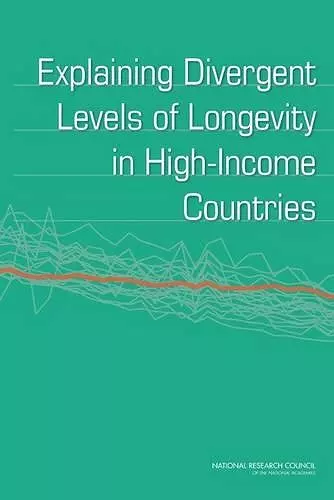Explaining Divergent Levels of Longevity in High-Income Countries
National Research Council author Division of Behavioral and Social Sciences and Education author Committee on Population author Panel on Understanding Divergent Trends in Longevity in High-Income Countries author Barney Cohen editor Samuel H Preston editor Eileen M Crimmins editor
Format:Paperback
Publisher:National Academies Press
Published:27th Jul '11
Currently unavailable, and unfortunately no date known when it will be back

During the last 25 years, life expectancy at age 50 in the United States has been rising, but at a slower pace than in many other high-income countries, such as Japan and Australia. This difference is particularly notable given that the United States spends more on health care than any other nation. Concerned about this divergence, the National Institute on Aging asked the National Research Council to examine evidence on its possible causes.
According to Explaining Divergent Levels of Longevity in High-Income Countries, the nation's history of heavy smoking is a major reason why lifespans in the United States fall short of those in many other high-income nations. Evidence suggests that current obesity levels play a substantial part as well. The book reports that lack of universal access to health care in the U.S. also has increased mortality and reduced life expectancy, though this is a less significant factor for those over age 65 because of Medicare access. For the main causes of death at older ages—cancer and cardiovascular disease—available indicators do not suggest that the U.S. health care system is failing to prevent deaths that would be averted elsewhere. In fact, cancer detection and survival appear to be better in the U.S. than in most other high-income nations, and survival rates following a heart attack also are favorable.
Explaining Divergent Levels of Longevity in High-Income Countries identifies many gaps in research. For instance, while lung cancer deaths are a reliable marker of the damage from smoking, no clear-cut marker exists for obesity, physical inactivity, social integration, or other risks considered in this book. Moreover, evaluation of these risk factors is based on observational studies, which—unlike randomized controlled trials—are subject to many biases.
- Front Matter
- Summary
- 1 Difference Between Life Expectancy in the United States and Other High-Income Countries
- 2 Causes of Death, Health Indicators, and Divergence in Life Expectancy
- 3 The Role of Obesity
- 4 The Role of Physical Activity
- 5 The Role of Smoking
- 6 The Role of Social Networks and Social Integration
- 7 The Role of Health Care
- 8 The Role of Hormone Therapy
- 9 The Role of Inequality
- 10 Conclusions
- References
- Biographical Sketches of Committee Members and Staff <
ISBN: 9780309186407
Dimensions: unknown
Weight: unknown
194 pages